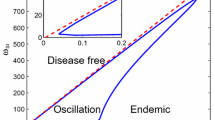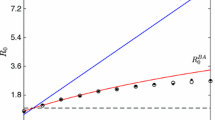Abstract
This paper concerns the SIR dynamics with two types of spreading mechanism, i.e., local spreading through network contacts and global spreading through casual contacts. A low-dimensional edge-based model of ordinary differential equations incorporating arbitrary heterogeneous number of individual contacts is formulated. The basic reproduction number \(R_{0}\) is obtained, and on networks of Poisson type, it is the sum of the basic reproduction numbers for global and local spreading pathways; however, on networks of other type, it is a nonlinear function of the basic reproduction numbers for global and local spreading pathways. To measure the control efforts imposed on one specific transmission pathway, type reproduction numbers for global and local transmission pathways are calculated, respectively. Equations of the final epidemic size are analytically derived. Finally, the numerical solutions to our model are compared with the ensemble averages of the stochastic simulations. Simulations have shown that casual contacts in the population may trigger large stochastic fluctuations, which may cause huge variances around their mean; thus, in this scenario the ensemble mean is not a good representation of the behavior of the stochastic epidemic process. However, increasing the local infection rate or the connectedness of networks yields better predictions. The results presented provide insights in setting a framework for the analysis and containment of multiple routes of epidemic transmission in reality.











Similar content being viewed by others
References
Anderson, R.M., May, R.M.: Infectious Diseases of Humans: Dynamics and Control. Oxford University Press, Oxford (1992)
Hethcote, H.W.: The mathematics of infectious diseases. SIAM Rev. 42, 599–653 (2000)
Diekmann, O., de Jong, M.C.M., Metz, J.A.J.: A deterministic epidemic model taking into account of repeated contacts between the same individuals. J. Appl. Prob. 35, 448–462 (1998)
Pastor-Satorras, R., Vespignani, A.: Epidemic spreading in scale-free networks. Phys. Rev. Lett. 86, 3200–3203 (2001)
Moreno, Y., Pastor-Satorras, R., Vespignani, A.: Epidemic outbreaks in complex heterogeneous networks. Eur. Phys. J. B 26, 521–529 (2002)
Newman, M.E.J.: Spread of epidemic disease on networks. Phys. Rev. E 66, 016128 (2002)
Newman, M.E.J., Strogatz, S.H., Watts, D.J.: Random graphs with arbitrary degree distributions and their applications. Phys. Rev. E 64, 026118 (2001)
Albert, A., Barabási, A.L.: Statistical mechanics of complex networks. Rev. Mod. Phys. 74, 47–97 (2002)
Molloy, M., Reed, B.: A critical point for random graphs with a given degree sequence. Random Struct. Algorithms 6, 161–180 (1995)
Jones, H.J., Handcock, M.S.: An assessment of preferential attachment as a mechanism for human sexual network formation. Proc. R. Soc. Lond. B 270, 1123–1128 (2003)
Musso, D., Roche, C., Robin, E., et al.: Potential sexual transmission of Zika virus. Emerg. Infect. Dis. 21, 359–361 (2015)
Mate, S.E., Kugelman, J.R., Nyenswah, T.G., et al.: Molecular evidence of sexual transmission of Ebola virus. N. Engl. J. Med. 373, 2448–2454 (2015)
Ball, F., Neal, P.: A general model for stochastic SIR epidemics with two levels of mixing. Math. Biosci. 180, 73–102 (2002)
Kiss, I.Z., Green, D.M., Kao, R.R.: The effect of contact heterogeneity and multiple routes of transmission on final epidemic size. Math. Biosci. 203, 124–136 (2006)
Wang, Y., Jin, Z., Yang, Z.M., et al.: Global analysis of an SIS model with an infective vector on complex networks. Nonlin. Anal. RWA 13, 543–557 (2012)
Wang, Y., Jin, Z.: Global analysis of multiple routes of disease transmission on heterogeneous networks. Physica A 392, 3869–3880 (2013)
Wang, Y., Cao, J.D.: Global dynamics of a network epidemic model for waterborne diseases spread. Appl. Math. Comput. 237, 474–488 (2014)
Wang, Y., Cao, J.D., Alofi, A., et al.: Revisiting node-based SIR models in complex networks with degree correlations. Physica A 437, 75–88 (2015)
Ball, F., Neal, P.: Network epidemic models with two levels of mixing. Math. Biosci. 212, 69–87 (2008)
Lindquist, J., Ma, J., van den Driessche, P., Willeboordse, F.H.: Effective degree network disease models. J. Math. Biol. 62, 143–164 (2011)
Volz, E.M.: SIR dynamics in random networks with heterogeneous connectivity. J. Math. Biol. 56, 293–310 (2008)
Miller, J.C.: A note on a paper by Erik Volz: SIR dynamics in random networks. J. Math. Biol. 62, 349–358 (2011)
Miller, J.C., Slim, A.C., Volz, E.M.: Edge-based compartmental modelling for infectious disease spread. J. R. Soc. Interface 9, 890–906 (2012)
Koch, D., Illner, R., Ma, J.: Edge removal in random contact networks and the basic reproduction number. J. Math. Biol. 67, 217–238 (2013)
Li, M., Ma, J., van den Driessche, P.: Model for disease dynamics of a waterborne pathogen on a random network. J. Math. Biol. 74, 961–977 (2015)
Kermack, W.O., McKendrick, A.G.: A contribution to the mathematical theory of epidemics. Proc. R. Soc. A 115, 700–721 (1927)
Diekmann, O., Heesterbeek, J.A.P., Metz, J.A.J.: On the definition and the computation of the basic reproduction ratio \(R_{0}\) in models for infectious diseases in heterogeneous populations. J. Math. Biol. 28, 365–382 (1990)
Ma, J., Earn, D.J.D.: Generality of the final size formula for an epidemic of a newly invading infectious disease. Bull. Math. Biol. 68, 679–702 (2006)
Miller, J.C.: Mathematical models of SIR disease spread with combined non-sexual and sexual transmission routes. Infect. Dis. Model. 2, 35–55 (2017)
Karrer, B., Newman, M.E.J.: Message passing approach for general epidemic models. Phys. Rev. E 82, 016101 (2010)
Feld, S.L.: Why your friends have more friends than you do. Am. J. Sociol. 96, 1464–1477 (1991)
van den Driessche, P., Watmough, J.: Reproduction numbers and sub-threshold endemic equilibria for compartmental models of disease transmission. Math. Biosci. 180, 29–48 (2002)
Roberts, M.G., Heesterbeek, J.A.P.: A new method for estimating the effort required to control an infectious disease. Proc. R. Soc. Lond. B 270, 1359–1364 (2003)
Heesterbeek, J.A.P., Roberts, M.G.: The type-reproduction number \(T\) in models for infectious disease control. Math. Biosci. 206, 3–10 (2007)
Wang, Y., Cao, J.D., Alsaedi, A., Ahmad, B.: Edge-based SEIR dynamics with or without infectious force in latent period on random networks. Commun. Nonlin. Sci. Numer. Simulat. 45, 35–54 (2017)
Gillespie, D.T.: A general method for numerically simulating the stochastic time evolution of coupled chemical reactions. J. Comput. Phys. 2, 403–434 (1976)
Gillespie, D.T.: Exact stochastic simulation of coupled chemical reactions. J. Phys. Chem. 81, 2340–2361 (1977)
Acknowledgements
The Project was supported by the Fundamental Research Funds for the Central Universities, China University of Geosciences (Wuhan) (No. CUG170622), and was partially supported by the National Natural Science Foundation of China under Grant Nos. 61573096 and 61272530.
Author information
Authors and Affiliations
Corresponding author
Rights and permissions
About this article
Cite this article
Wang, Y., Cao, J., Li, X. et al. Edge-based epidemic dynamics with multiple routes of transmission on random networks. Nonlinear Dyn 91, 403–420 (2018). https://doi.org/10.1007/s11071-017-3877-3
Received:
Accepted:
Published:
Issue Date:
DOI: https://doi.org/10.1007/s11071-017-3877-3




